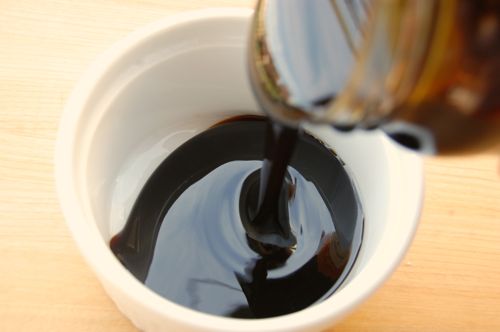Molasses

Molasses as you know is a by-product of the sugar making process. It can be made from either cane or beets, though beet molasses isn’t used much here in States (Europeans do use it some, however). As was mentioned in the sugar posts from last week, sugar is made by adding “seed” crystals to a volume of long-cooked, drastically reduced cane juice. The mixture forms crystals and the whole mess is then spun in a centrifuge (basically a big basket lined with cloth) and the thick liquid molasses is pulled out via centrifugal force.
All molasses has at least some uncrystallized sucrose in it since the crystallization process is never entirely successful. It also has plenty of other stuff: long-chain (non-sucrose) sugars, proteins, minerals, and bits of cane plant. The extended cooking of the juice browns the plant bits and caramelizes some of the sugars, and those are what give the molasses its color.
The cooking also does something else: it creates invert sugar. Cane juice is acidic to begin with, but only becomes more so as it cooks, since the brown, broken molecules that result from caramelization are also acidic. Combine that with heat and sucrose and you get a sucrose-glucose-fructose syrup that’s remarkably resistant to crystallization.
The act of crystallizing and centrifuging sugar is called a “strike” in the industry. The molasses that the “first strike” produces is called, unsurprisingly, “first strike” molasses, or more succinctly “first” molasses. It’s the lightest and sweetest of the three molasses varieties as it contains the most residual uncrystallized sucrose. It’s sometimes called “Barbados” molasses.
If that batch of first molasses is subjected to a second strike, the result is “second” molasses, which as you might expect, is a bit darker and less sweet. After that there is often a third strike, which removes virtually all the remaining sucrose. What’s left is a highly concentrated goo of complex long-chain sugars (which because of their molecular configuration don’t taste especially sweet on our tongues) and assorted and sundry browned stuff. This is what’s known as “black strap” (stroop) molasses. It’s the cheapest of the three, but also has the most nutrients (especially iron).
Molasses was the corn syrup of the industrial age, but does have a very strong flavor relative to corn syrup, which is why we tend not to use it so much anymore.
So is black treacle the same as molasses, or does it differ somehow? It is the nearest thing I’ve seen here in the UK to the molasses I grew up with, but I have no idea what it equates to in relation to which strike, if it is molasses.
I do believe now that perhaps the “dark” syrup I can get here could be a okay substitute, but its loose like honey-I’ve always thought the stuff should be thicker… perhaps its the first or second batch. I don’t personally think it has toooo much taste.
Taste profile of the different forms if you can perhaps?
I don’t know, honestly. You mostly see darker molasses in stores. I think it could be a first molasses, actually.
Thanks Kitty!
– Joe
yeah, a first makes sense, its rather runny, has SOME taste but not as I’d expect. ho hum. Guess it will have to do.
note that they also have a cane syrup of the dark sorts that is ever so slightly thicker and has a different taste to it, but still not as I’d have thought.
The image/product info for that one is NOT on the uk site, but here is a direct image link http://www.mediabanken.se/NordicSugar/Mediabank/image.aspx?opvno=94379925&itype=Jpg300p
This stuff costs 3 times as much as the dark syrup for half as much. same viscosity though.
the normal dark syrup tastes almost like chocolate.
The cane tastes good, just not like brown sugar tastes (and the muscovado sugar has big chunks of what I assume is closest to what I actually want for the flavor)
Interesting. Thanks Kitty. I hope you find what you need after all of this!
– Joe
What is the “cane syrup” available in the south (one of my favorite substances)? It’s often touted as “open kettle”, which leads me to believe its just boiled-down cane juice. Is it the same as the “golden syrup” or treacle I’ve seen imported from England? The sorghum syrup I can buy here in the upper Midwest is the same, but made from a different plant, right? It’s much more molasses-y than cane syrup, but it’s the closest I can get to the Southern variety.
Hey Tereza!
Southern “cane syrup” is just as you describe…boiled down cane juice, pure and simple. And indeed it is like sorghum…which I’ll be getting to!
Thanks for the comment!
– Joe